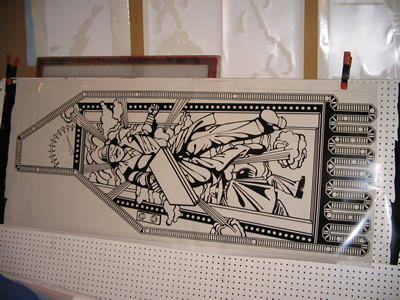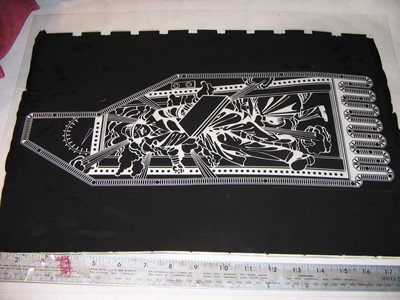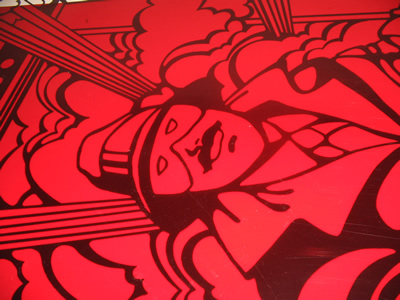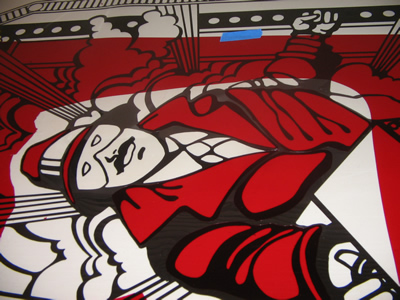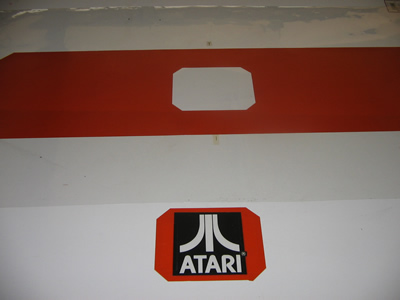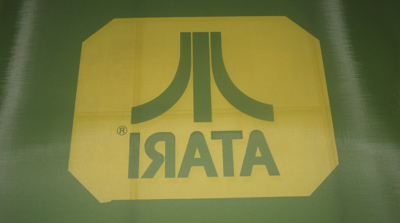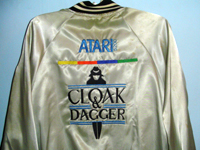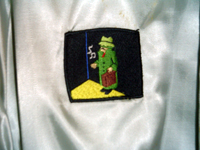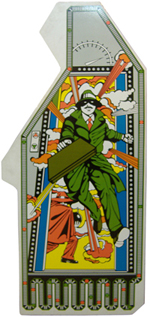Oversize films at This Old Game
As I have gotten to know Rich over the past 6-9 months I have gotten to know a lot about his business and how the production moves from the initial interest of a reproduction artwork project down to the final physical pieces. Sending out films for production that are considered oversize can add a little bit of time to a project. Well, Rich recently got a doozie of a deal that is going to make his capabilities to print full size arcade sideart much easier. (more…)
Agent X / Cloak & Dagger Kickplate Artwork Film Updates
Got a nice surprise sitting in my email when I got in last night to check. Rich just got the films back for the Agent X kickplate artwork for the complete package he is printing for Rick Ford. It was tremendous to see a final printed piece of arcade artwork in the Professor Pacman control panels, but to see this artwork is even more exciting.
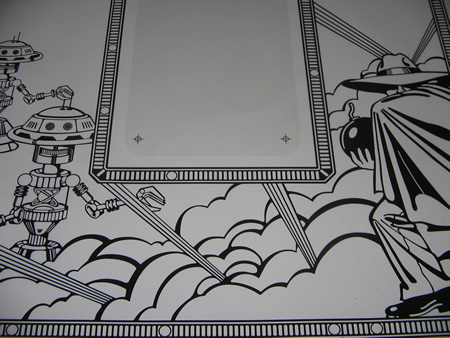
Agent X Color Screens
This week, Rich at This Old Game gave me a few moments of his time and sent me some photos of the screen printing process of the in progress Atari Agent X sideart. A short history here, back in September of 2007, This Old Game announced that they would be producing a full kit of artwork including cabinet plans to build authentic artwork covered Atari Agent X cabinets. Well known arcade enthusiast Rick Ford was the catalyst, wanting a cabinet for himself, and making arrangements with both Scott Evans to get the original Atari films and me to remake the kickplate as a vector artwork file.
Fast forward to today, February 2008. Rich is in the process of printing the sideart, paying close attention to costing. Side art is challenging to reproduce and still be competitive in the small industry that is the arcade reproduction artwork business. There are a number of reasons why reproduction artwork is costly, mostly dealing with demand in relation to cost of production and cost of technology to print oversize films.
Here we see a couple of photos of the detailed Agent X side artwork. (Click on the photos for larger views)
The first is a photo of the Agent X sideart film from Scott Evans, you can see the blacks look like they are printed on a clear acetate. This negative image film will be used to burn screens to print the different colors. Now, keep in mind, there are six colors in total (green, orange, blue, yellow, grey & of course black) that would be printed on a white vinyl. The films here are scaled down to 11 x 17, effectively one fourth the actual size. They will then be blown up to full size sideart at a height of six feet.
Each of the five Agent X films would have cost at least $100 to burn at those dimensions, not to mention, there are some discrepancies between the original film and the final artwork that was printed on the limited existing Agent X machines. Here is a PDF demonstrating some of those inconsistencies in color, and here is the topic on Klov with some of the members talking about whether to leave the film original or correct the color errors. The final machines indicated that Atari would have had made adjustments to the film to change the colors midway through production.
In an effort to keep the artwork more affordable, the two Rich’s decided to not burn individual films and instead implement some masking with Rubylith. What is Rubylith you ask? Well, I actually asked that myself.
Rubylith was started originally as a brand of masking film, invented and trademarked by Ulano Corporation. But over time the brand became so generalized it became synonymous with masking, much like Kleenex are to tissues. Here is how Wikipedia explains Rubylith;
Rubylith consists of two films sandwiched together. The bottom layer is a clear polyester backing sheet. The top layer is a translucent, red coloured, self adhesive, emulsion. It is designed to be both easy to cut with a knife and light safe for use with orthochromatic films.
Instead of making films for each color, Rich will apply each color individually, masking off the one full size film for each run of the six colors. Take a look at the two photos below for a demonstration.
First he covers the whole film in the Rubylith, and then he uses a pattern to identify which sections to retain for the color he is printing and which sections to cut and remove. In this case, he is making the film for the green. (This is a test piece, if it was the real film, could you identify a incorrectly cut away piece of rubylith based on the sideart colors?) The film with the clear acetate is then placed on a screen, covered in light sensitive emulsion and any area that is not covered in rubylith is exposed and burned into the screen. The areas with Rubylith are blocked and the emulsion just washes away.
All of the pre-ordered artwork will be printed in this way. One color is printed on all of the vinyl pieces, then clean off the film and start all over again with a full covering of rubylith, remove and retain pieces of mask to achieve each of the other four colors other than black.
Rubylith can also be implemented for spot fixes and spot colors. Using it’s masking abilities and sensitivities to particular spectrums of light (Red, Green, and Blue), you can go back to already printed artwork and add back in missing colors or fix errors in the print. Here are a couple of examples.
Here we see the speaker grill rubylith cutout with the Atari logo. Neither the rubylith or the black will be exposed on the screen. This is the screen for the middle red of the speaker grill overlay.
Here is the exposed film. Cut by hand, you can see the little bump in the lower left corner that can be easily fixed with a liquid filler or even a piece of tape to get a straight – but angled edge.
Again, thanks to Rich for an insight into the printing process. Hopefully he’ll continue to have a few minutes here and there to provide more information to those of us that are interested about the progress of all of his printing jobs.
So, remember, if you don’t have a printer yet for your arcade reproductions, you will want to look up Rich at Thisoldgame.com
You got it here first, exclusive content about the Atari Agent X / Cloak and Dagger artwork films and printing progress at Rotheblog.com.
Agent X / Cloak Dagger Jacket
Yesterday I got an interesting email from another collector interested in Agent X information. His name is Alan, and he was looking for photos of an Agent X machine.
After an email exchange, he told me that he knew Dave Comstock, who was the Atari programmer that was supposed to port Cloak and Dagger over to the 5200. Dave Comstock owns one of the original Agent X machines, from the limited run that were produced. (That information is readily available on the internet.) Alan also mentioned that he owns a Cloak and Dagger jacket, only two were ever made. I thought that was kind of interesting and obscure, so here are two photos of the jacket below.
I haven’t asked him yet, but depending on his relationship with Dave, maybe he bought one of the jackets from him. I am sure Dave has a ton of old Atari stuff since he is a former employee.
~Edit Alan had the Cloak and Dagger jackets made, so this particular arcade item wasn’t made by Atari. But it is definitely something you don’t see all the time.
Atari Agent X / Cloak Dagger Reproduction Artwork Update
This Old Game hadn’t updated progress on the Atari Agent X reproductions, so I thought I would email Rich and find out what was new. I heard back, and it sounds like things are progressing.
If you haven’t read anything about this set of Agent X reproductions before now, here is a short run down. Rick Ford has coordinated a project to get all of the artwork reproduced to build a complete Agent X machine. The Agent X artwork includes the marquee, speaker grill overlays, control panel overlay, kickplate, and sideart.
Originally the reproductions were going to be a very limited run, but there was some increased interest on the arcade forums when Rick made his announcement. Rich had made great progress getting each of the pieces printed, the marquee, the speaker grills, etc. But with the increased interest, he had to go back and print some more of that Agent X artwork. The films for these pieces of art are on loan from Scott Evans, so the quicker those pieces of Atari art can be finished, the better.
Once the catchup is finished, all of the final details can be worked out on the Agent X kickplate and sideart. That is exciting news, I can’t wait to finally see the Agent X kickplate artwork that I did get reproduced. The kickplate was pretty complex, and here is what Rich had to say about the Agent X sideart;
The films for the Agent X sideart were in small negative form, which I then had blown up to a full sized camera positive. I’ve also had a custom screen made to accomodate this big of a piece of artwork.
It turned out the guy I went through to make the screen worked in Atari’s production deptartment from 1979-1984. Kind of a cool story, and he had lots of insight too in regards to materials and production runs of the artwork.
The films are made for the sideart, all he needs to do is lay down the colors for the print. After the holidays are done, it would seem as the Agent X artwork could be finished sometime in January of 2008.
Here are a few of the images from ThisOldGame.com showing the screens that have been made, three images of the screen printing process of the Agent X marquees, and one photo of the speaker grill overlays.
Image of the Agent X kickplate
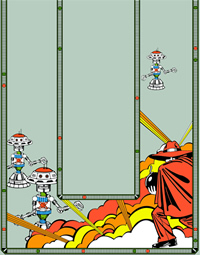
It’s been a week, and I don’t have dimensions just yet, so I thought I would post what I have. If I haven’t said this before, I will say it now. JPG quality is for the web, and is not representative of print colors. So keep that in mind when viewing, that and this hasn’t been color matched yet.
Some History on Atari’s Agent X

I have met one owner of an Agent X arcade game, although I didn’t know anything about it when I met him, nor did I even see the game during my visit. It wasn’t until successive conversions later that I found out about Agent X’s rarity.
This is what Joe had to say about Agent X, recalling as best he could the history of the game off the top of his head and what he had to go through to find his;
“On the Cloak & Dagger, it gets a little collector/geeky/anal. When Atari originally developed the game, the name was Agent X. Then Hollywood made the movie Cloak & Dagger and asked Atari to make a game for it. Agent X was already a version of the game. Rumor has it that only 20 dedicated Agent X units were ever made and these were only made for field testing purposes, they were never meant for public release. Of those 20, 7 were Agent X, and the other 13 were Cloak & Dagger. Cloak & Dagger was released for general purchase in kit only form, for converting other games, specifically Williams games (Stargate, Defender, Robotron, Joust). So game play wise, Agent X and Cloak & Dagger are exactly the same, only difference is the title screen.”
“Cabinet wise, conversion units are cheap and relatively easy to find. They sell on ebay for less than $400. Dedicated units are close to impossible, as there were only 20 or so made, and the ones out there are typically in collectors hands that don’t want to sell them. The last one I heard selling was a Cloak & Dagger which sold for $3,000. An Agent X is even more rare. At one point someone offered me $10,000 for my Agent X. I’m sure that’s no longer a valid offer as that person has since got a dedicated Cloak & Dagger. But it was a nice offer to get. Certainly one of the most valuable in my collection.”
“Probably way more information than you wanted, but it’s one of my prize games, so I like talking about it! It was a pretty big search to find and get.”
So basically my interpretation of this information is that of the few Agent X’s that were produced, most of them are or at one time were owned by Atari employees. Now they made have made their hands into serious collectors who know their value, similar to Joe, but the only way you might get one is to start the way he did and track down some old Atari employees.
Why reproduce artwork for Agent X?
Well, for two main reasons. I like the two people I have met, so it is a good opportunity to show them some good will in networking. Also, because Agent X is so rare, hopefully it will mean I am one of the few people who have a copy of vector artwork for the Agent X kickplate, sideart, marquee, speaker overlays, control panel, or whatever else I decided to vectorize and prepare for reproduction.
Update – March 23, 2009
If you look below in the comments, one of the original creators that worked on Agent X left a comment, and basically confirmed all of the information that Joe shared about the game. I have no doubts that on his hunt Joe probably talked with Rusty about the history and that is where most of his ‘unconfirmed’ rumors came from.

